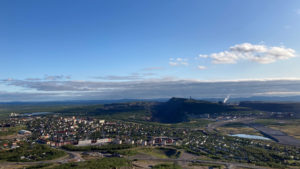
Urban transformations in the Arctic – this was the topic of a Summer School at the Luleå University of Technology in Kiruna/Giron, in which Jacqueline Götze participated.
From 16 to 20 August 2021, Jacqueline Götze, researcher at the German Development Institute / Deutsches Institut für Entwicklungspolitik (DIE) in the DFG-funded research project on ‘Sustainable Urban Development in the European Arctic (SUDEA)’, participated in a PhD Summer School on ‘Sustainable urban development in resource-extraction territories: the Arctic as a case study’ organised by the Arctic Five cooperation. The school was taking place at the Kiruna campus of the Luleå University of Technology (LTU). Taking Kiruna (in Northern Sami, Giron) as a case study for urban transformations in the Arctic, the school was focusing on the unique characteristics and challenges the city is facing.
Kiruna/Giron is located 200 km north of the Arctic Circle and is thus, the northernmost city of Sweden. The area belongs to the traditional land of the Saami (Sápmi) and since 1993, the city hosts the Swedish Sámi Parliament. The official narrative on Kiruna/Giron represents it as a mining city – as the largest underground iron ore mine in the world is operating under the city. Due to mining operations and its impacts on the environment, parts of the city including the new city centre currently need to be relocated, which is a process that takes place over decades. However, the city stands for much more than just the mine: for its Saami population and traditional economic activities such as reindeer herding, gathering and handicrafts, for science (the Esrange Space Center, the Institute of Space Physics and LTU’s department of Space Science are all located in the city) and for (eco-)tourism.
The participants of the school were introduced to different concepts of Arctic urbanity, its challenges and prospects. Following a transdisciplinary approach, speakers were invited from different disciplines, for instance architecture, business, political science and human rights and from various areas, such as academia, policy officials and civil society. In addition to the lectures and discussions in class, the group also visited different locations in and outside Kiruna/Giron such as the new city hall, the Nutti Sámi Siida and the small mining village Svappavaara. Topics and potential solutions discussed in the school dealt with the resource-urbanisation nexus, colonialism and forced relocations of Saami people, architecture and city planning, urban Saami identities as well as business-society interactions.
Schreibe einen Kommentar